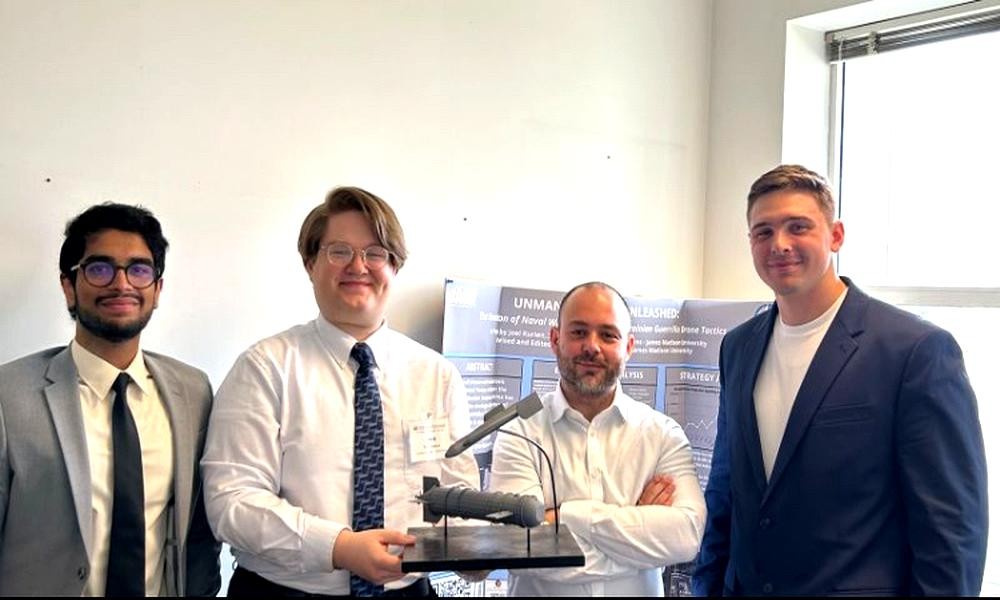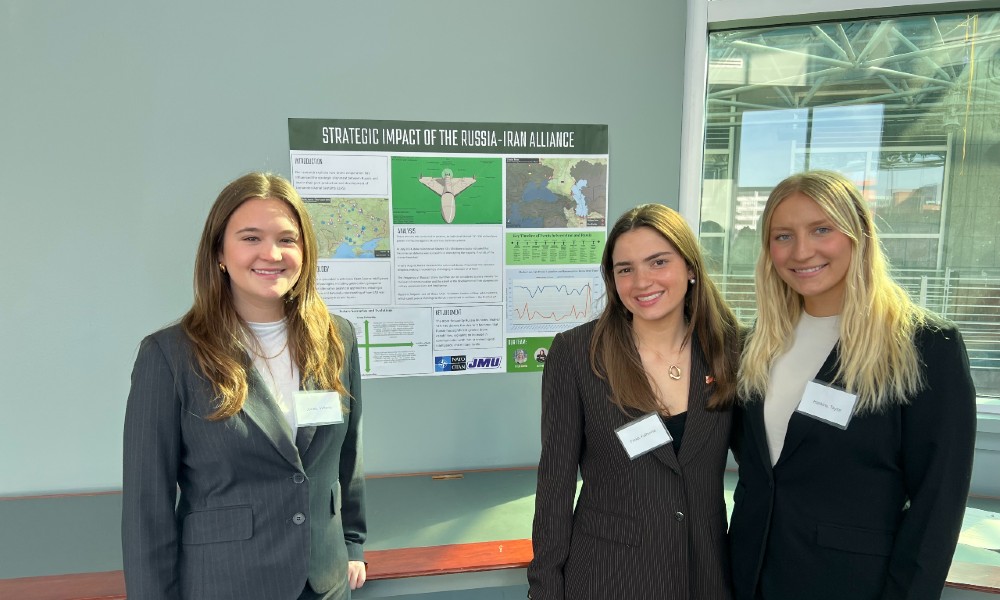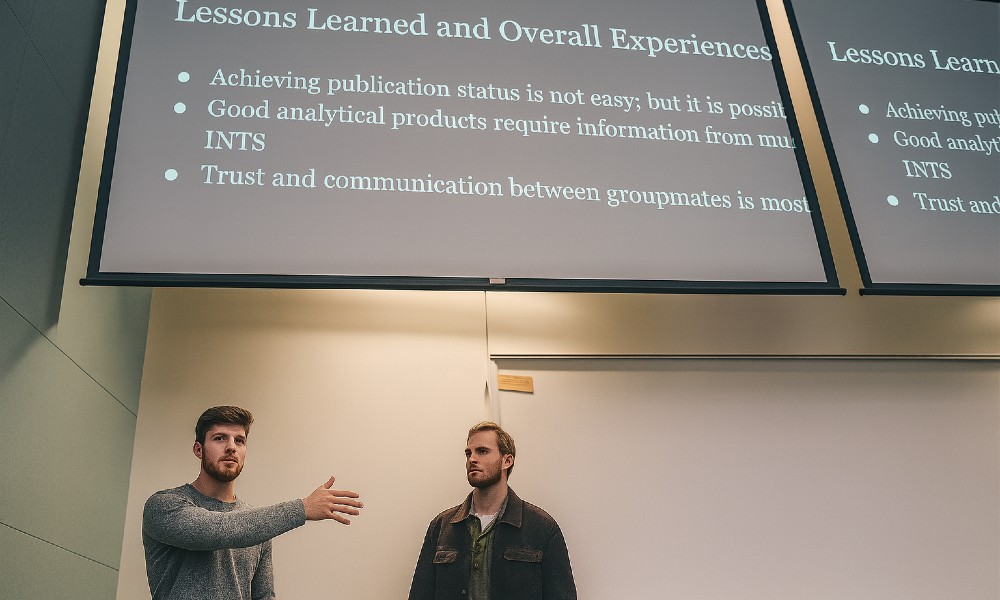Beyond the classroom: IA student research earns global recognition
News
SUMMARY: IA students are analyzing global conflict using satellite data, campaign modeling, and open-source intelligence to track geopolitical behavior and emerging threats. Their research has been published, presented at national symposiums, and accepted by NATO-affiliated outlets — an extraordinary achievement for undergraduates.
A vessel surfaces near the Black Sea, appearing only as a shadow on satellite images. Its name disappears from official records, and its route defies logic. Only after tracing it back — through open-source logs, quiet ports and international waters — can its origin be confirmed: a tanker that vanished off the Libyan coast days earlier.
This is how modern conflict hides in plain sight, and students in JMU’s Intelligence Analysis program are exposing it.
Analyzing global conflict
Armed with the same analytical frameworks used in professional intelligence work, these students are making it their mission to understand how modern conflict moves — quietly, strategically and often just out of view.
Using a combination of satellite data, campaign modeling, and open-source intelligence (OSINT) tools, IA students are mapping international behavior and forecasting potential future developments. It’s the kind of analysis they’ve learned to conduct — carefully, methodically and with a global perspective.
“This isn’t theory,” said IA professor Giangiuseppe Pili. “They’re analyzing global conflict as it unfolds and figuring out what it means.”
Each project begins with a question — often sparked by a need identified in the analytic community or a media inquiry. Then the real work begins. Students gather fragmented information from public sources, organize and analyze data, test assumptions and build a coherent picture of what’s really happening.
Using OSINT, students extract data from shipping logs and port authorities, cross-check locations against satellite imagery, analyze patterns in state-run media and track construction in contested territories. In one case, IA students Samantha Rickwalder and Jason Clark noticed changes in Chinese military exercises in the Taiwan Strait.
Sometimes the data is clear, and often it’s a mess, but that’s part of the point. “They’re learning to deal with ambiguity,” Pili explained. “To make sense of partial information. That’s what intelligence work really is.”
Gaining international attention
IA students aren’t just learning. They’re producing work that’s gaining international attention.
Ivanna Renderos, Andrew Corbett and Luke Velasquez produced a report on Arctic security, analyzing the geopolitical consequences of a rapidly melting region. Their research combined satellite mapping, economic forecasts, and infrastructure analysis to explore how Russia and China might adjust their strategies as sea ice disappears and trade routes become accessible.
Brett Evans and Ryder Finn co-authored a paper with Pili on Russian artillery warfare, published by the Royal United Services Institute, the world's oldest independent defense and security think tank. The article was widely shared by international experts and picked up by major news outlets across Europe and the United States — a rare achievement for undergraduate researchers to reach such a prestigious platform.
(L-R): Victoria Jones, Katie Fricke and Taylor Hankins
Victoria Jones, Katie Fricke and Taylor Hankins presented their research on the growing military alliance between Russia and Iran at a symposium in Washington, D.C. Their analysis focused on how Iranian-supplied drones have shifted battlefield strategies in Ukraine and are now being deployed in the Middle East — and was recently featured by the NATO Defense College.
These projects, along with additional reports by Sam Rooker, Joel Kurien, and Ryan Stevens, have all been accepted for review and inclusion in a NATO-affiliated research outlet. This archive houses reports reviewed by international experts in security and defense strategy, and undergraduate inclusion represents an almost unprecedented recognition of student-authored intelligence analysis.
|
“This kind of exposure is rare in NATO’s history. What impresses experts isn’t just that undergraduate students are doing this work. It’s that the work is worth reading and worth sharing.” — Giangiuseppe Pili |
Pili views this as a turning point, not just for his students, but for how undergraduate research is perceived. “This isn’t a classroom simulation,” he said. “It’s applied, experiential learning, and students are beginning to see that their research has real-world value.”
With growing fluency in professional intelligence methodologies, students are refining drone warfare models, expanding threat assessments on Russian partnerships and deepening their analysis of strategic shifts in the Mediterranean.
Modeling real-world methods
This methodological approach builds directly on Pili’s professional experience and recent research. In 2024, he authored a report detailing Russia’s presence in the Mediterranean, which was accepted by NATO’s Defense College’s Research Division under the leadership of Dr. Florence Gaub, a prominent voice in European security. “None of this would have been possible without Dr. Gaub’s trust and belief in the importance of our research,” Pili said.
His report suggests that Russia’s aging Mediterranean Squadron isn’t intended to fight NATO head-on. “It’s meant to be visible, but not threatening,” Pili said. “It’s anchored by port access in Syria and backed by a ‘ghost fleet’ of unmarked oil tankers that help finance the war effort while quietly evading sanctions.
These tankers operate in the shadows. They shut off tracking, swap flags and disguise their cargo. But they’re still there. You just have to know how to look.”
That report became a case study for his students, demonstrating how OSINT can reveal hidden patterns in global conflict. Now, many of them are carrying it forward — expanding their research, applying the same analytical tools to track Chinese vessels and other players — moving just under the radar.
|
“Students don’t need access to classified data to make sense of what’s happening. They’re learning how to collect and analyze open-source information to build meaningful insights. This represents a fundamental shift in how we approach intelligence education. We are proving that rigorous analysis of publicly available information can yield professional-grade results.” — Giangiuseppe Pili |
One of Pili’s core principles: You don’t need a security clearance to do real intelligence work. What matters is having the right tools, critical thinking skills, strong methodologies, a solid analytical framework and the persistence to ask better questions.
Students are quietly producing threat assessments and strategic forecasts that could one day inform national security or private-sector decision-making — but for them, it’s not about recognition. It’s about seeing the world more clearly — through ambiguity, through noise and through the gaps where most people stop looking.
Shaping future analysts
As the spring semester wrapped up, students delivered their final presentations — briefings built on months of research, analysis and iteration. Some expanded on previous projects, treating them as evolving case files. Others launched entirely new inquiries, scanning the global landscape for emerging threats and overlooked trends.

Ryder Finn and Brett Evans deliver their final IA presentation.
The topics covered new ground and extended earlier research, from maritime tensions and arms diplomacy to shifts in regional influence. Each presentation reflected the same core strengths: critical thinking, strategic modeling, a strong technical skillset and a deep curiosity about how power operates in the world.
Pili offers feedback and nudges students to refine their logic, test their assumptions and go deeper. While he may pose the initial question, he encourages students to develop new problems and questions as their work unfolds. “They’re often in a better position to define what matters,” he said. “They have to figure out how to solve the problem on their own, and they absolutely do, with minimal supervision from me.”
